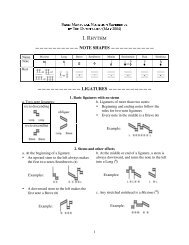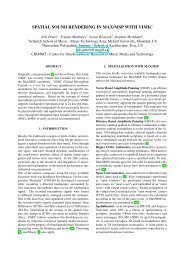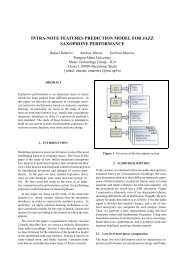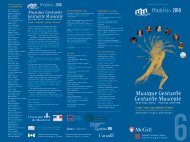Sound Kitchen: Designing a Chemically Controlled Musical - CiteSeer
Sound Kitchen: Designing a Chemically Controlled Musical - CiteSeer
Sound Kitchen: Designing a Chemically Controlled Musical - CiteSeer
Create successful ePaper yourself
Turn your PDF publications into a flip-book with our unique Google optimized e-Paper software.
Proceedings of the 2003 Conference on New Interfaces for <strong>Musical</strong> Expression (NIME-03), Montreal, Canada<br />
sounds inside a test tube. The products of all acid/base<br />
reactions are a salt, water, and carbon dioxide gas:<br />
Acid + Base −→ salt + water + carbon dioxide gas<br />
The specific reaction in this system is:<br />
CH3COOH + NaHCO3 −→ NaC2H3O2 + H2CO3<br />
where CH3COOH is acetic acid, NaHCO3 is baking soda<br />
and NaC2H3O2 is sodium acetate. This is followed by<br />
H2CO3 −→ H2O + CO2<br />
where CO2 is a gas, dispersed as bubbles into the atmosphere.<br />
This part of the reaction causes a fizzing sound<br />
which is captured by microphones and processed as an acoustic<br />
signal.<br />
2.2 Electrolytes in Batteries<br />
Avoltage can be created when two polarized electrodes,<br />
e.g. copper and aluminum strips, are inserted in an electrolytic<br />
substance. The negative ions in the electrolyte are<br />
attracted to the aluminum strip, while positively charged<br />
ones are attracted to the copper strip. Temperature increase/decrease<br />
and electrolyte volume are used to control<br />
the total charge of the system.<br />
Citric Acid<br />
Citric acid, a prominent component of orange juice is represented<br />
by the chemical formula C6H8O7 · H2O. When the<br />
copper and aluminum (the electrodes) are submerged in the<br />
orange juice (the electrolyte), the hydronium ions (H3O + )<br />
of the orange juiceareattracted to the copper electrode and<br />
the C6H7O −<br />
7 ions are attracted to the aluminum electrode<br />
(Figure 2). 40 ml of orange juice are used to charge the<br />
stirring battery.<br />
Red Wine<br />
Red wine may contain three acid derivatives: benzoic acid<br />
derivatives, cinnamic acid derivatives, or flavonoid derivatives<br />
(Figure 3). This substance works much like that of<br />
orange juice except that the C6H7O −<br />
7 is replaced by one of<br />
the acid derivatives of the wine. 400 ml of water and 100 ml<br />
of red wine are used to charge the pouring battery.<br />
Temperature control<br />
In this system protons (H + )andhydroxide ions (OH − )are<br />
the attaching elements. After heating around 60 degrees<br />
Celsius, the electrolytic properties of water become more<br />
intense, therefore more interesting as a slow paced control<br />
signal. Heat increases the agitation of the ions in the electrolyte<br />
thereby increasing the flow of the electrons (Figure<br />
4). Our thermo-controlled battery uses a tea pot coil warmer<br />
to heat 250 ml of water.<br />
HO<br />
OH<br />
OH<br />
O<br />
O<br />
+<br />
OH<br />
O<br />
O<br />
H<br />
H<br />
HO<br />
OH<br />
OH<br />
O<br />
O<br />
O<br />
O<br />
+ H O<br />
Figure 2: Citric acid gives up one hydrogen ion to a<br />
water molecule resulting in negatively and positively<br />
charged molecules<br />
−<br />
H<br />
H<br />
+<br />
NIME03-84<br />
HO<br />
R1<br />
Cinnamic Acid Derivatives<br />
(where R1 and R2 are acids)<br />
HO<br />
R2<br />
OH<br />
O<br />
COOH<br />
R1<br />
Benzoic Acid Derivatives<br />
(where R1 and R2 are acids)<br />
R2 CH CH COOH<br />
OH<br />
R1<br />
OH<br />
R2 Flavonoid Derivatives<br />
(where R1 and R2 are acids)<br />
Figure 3: Three acid derivatives that occur in<br />
red wines - benzoic acid derivatives, cinnamic acid<br />
derivatives, and flavonoid derivatives<br />
Al +<br />
e −<br />
−<br />
OH<br />
H O<br />
2<br />
H +<br />
e −<br />
Cu<br />
−<br />
Vout<br />
Figure 4: The water battery system where water is<br />
the electrolyte and a copper strip and an aluminum<br />
strip act as electrodes<br />
3. ENGINEERING<br />
An ATMega163 controller[3] is used to capture, condition<br />
and transmit signals from sensors in the chemical framework.<br />
AVRGCC is used for coding. Out of six input signals<br />
to theATMega163, four output signals are sent to a PC after<br />
conditioning via the serial port using Open <strong>Sound</strong> Control<br />
(OSC) [4].<br />
3.1 Tubes and Microphones<br />
Four small microphones are used to capture the sounds<br />
of the reaction of acid and soda in the test tubes. Signals<br />
are sent directly to four loud speakers via a spatialization<br />
patch in Pd [5], e.g. the first tube to the front right speaker,<br />
the second to the front left, the third to the rear right, the<br />
fourth to the rear left. Before performance, the portion of<br />
vinegar and soda is carefully chosen not to damage the microphones<br />
with foamy acidic bubbles. The soldered parts of<br />
microphones are coated with hot glue, to prevent rust.<br />
3.2 Batteries<br />
Stirring Battery<br />
The Stirring Battery exhibits a chaotic voltage flow when<br />
the electrolyte is stirred with a circular motion. For musical<br />
reasons, this is turned on and off in a controlled way.<br />
An FSR (Force Sensitive Resistor) attached to the stirring<br />
stick implements this switching functionality: raw voltage<br />
signal when the stick is held, or zeros when not held (Figure<br />
5). Both signals from the FSR and the battery are sent to









